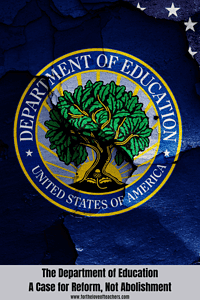The U.S. Department of Education (DOE) plays a crucial role in shaping the nation’s education system, directly impacting teachers and their classrooms. Since its establishment in 1979, the department has been responsible for enforcing federal education laws, distributing funding, and ensuring equal access to quality education. However, it has also been a topic of debate, with critics questioning its effectiveness and calling for its elimination.
Rather than abolishing the DOE, a more balanced approach would be to focus on meaningful reform. By addressing inefficiencies, reducing bureaucracy, and better supporting students and educators, the department can fulfill its mission more effectively. This article takes a non-biased look at the DOE’s functions, challenges, and areas for improvement, highlighting how reform can lead to a stronger education system for teachers and students alike.
The Functions of the Department of Education The DOE’s primary role is to oversee and support the U.S. education system, particularly at the K-12 and higher education levels. Some of its key responsibilities include:
- Distributing Federal Funding – The DOE allocates billions of dollars in grants, loans, and aid to schools, students, and state education agencies. Programs such as Title I provide additional resources to low-income schools, which many teachers rely on for classroom materials and student support. Pell Grants help students afford college, impacting educators in higher education as well.
- Ensuring Equal Access – Through the enforcement of federal education laws, such as the Individuals with Disabilities Education Act (IDEA) and Title IX, the DOE works to protect students from discrimination and ensure they receive necessary accommodations. Teachers play a crucial role in implementing these policies in their classrooms.
- Setting National Education Policy – While education is primarily a state and local responsibility, the DOE influences policies related to standardized testing, curriculum standards, and teacher qualifications, all of which directly affect educators’ day-to-day responsibilities.
- Conducting Research and Data Collection – Through organizations like the National Center for Education Statistics (NCES), the DOE collects data that helps policymakers and educators make informed decisions about curriculum, instruction, and funding priorities.
Challenges Facing the Department of Education Despite its important responsibilities, the DOE faces several challenges that impact teachers and the students they serve:
- Bureaucracy and Inefficiency – Many educators experience the delays and complexities of navigating DOE regulations, which can make it difficult to access funding and resources efficiently.
- Standardized Testing Concerns – Programs like No Child Left Behind (NCLB) and its successor, the Every Student Succeeds Act (ESSA), have emphasized standardized testing, sometimes at the expense of individualized learning and teacher autonomy. Many educators feel constrained by test-focused instruction rather than being able to tailor lessons to student needs.
- Funding Disparities – Public education funding primarily comes from state and local taxes, leading to significant inequalities between school districts. Teachers in underfunded schools often struggle with limited resources, larger class sizes, and fewer support staff.
- Higher Education Debt Crisis – The DOE manages federal student loans, but rising tuition costs and student loan debt continue to be major issues. Many teachers themselves struggle with loan repayment, making the profession less attractive to future educators.
Areas for Improvement: Strengthening the Department of Education Instead of eliminating the DOE, targeted reforms can help the department better serve students, teachers, and schools. Here are some key areas for improvement:
- Reducing Bureaucracy – Streamlining processes and eliminating unnecessary administrative hurdles can make it easier for schools and teachers to receive funding and support without excessive government interference.
- Reevaluating Standardized Testing – Shifting away from a one-size-fits-all approach to assessment can allow for more flexible and innovative teaching methods that cater to diverse student needs.
- Addressing Educational Inequality – The DOE should work with states to ensure that funding is more equitably distributed, so that low-income and rural schools receive the support they need, ultimately helping teachers provide better learning experiences for their students.
- Improving Higher Education Affordability – Expanding access to financial aid, regulating tuition increases, and reforming student loan programs can help ease the burden on college students, including those training to become teachers.
- Enhancing Teacher Support and Retention – The DOE can play a role in promoting better teacher training, fair wages, and professional development opportunities to combat teacher shortages and burnout, ensuring that educators feel valued and supported in their roles.
Conclusion: Reform Over Elimination The Department of Education plays a vital role in maintaining and improving the American education system. While it faces significant challenges, the solution is not to abolish the department but to reform it to function more efficiently and equitably. By addressing bureaucracy, funding disparities, and the overemphasis on standardized testing, the DOE can better serve students, educators, and communities across the country.
Teachers are at the heart of education, and thoughtful improvements to the DOE can ensure they receive the support they need to create thriving, well-equipped classrooms. A strong education system is fundamental to the nation’s success, and with the right reforms, the Department of Education can continue to be a force for positive change in the lives of teachers and students alike.
Key Takeaways:
- The DOE provides crucial funding, policy guidance, and legal protections that directly impact teachers and students.
- Bureaucratic inefficiencies, standardized testing pressures, and funding disparities present challenges to educators.
- Reforming the DOE—rather than eliminating it—can lead to better teacher support, fairer funding distribution, and reduced administrative burdens.
- Addressing student loan debt and higher education costs can make the teaching profession more accessible and sustainable.
- Teachers’ voices should be included in shaping education policies to ensure reforms truly meet their needs.
As an educator, what changes do you believe would make the biggest impact in your classroom? Share in the comments.
Thanks for reading!
If you like it, then pin it!

Christine Weis is a passionate educator, classroom management coach, wife, and mom of two busy boys. She enjoys teaching, writing, and creating resources for teachers.







Leave a Reply